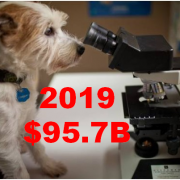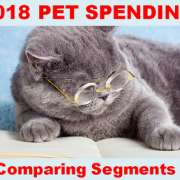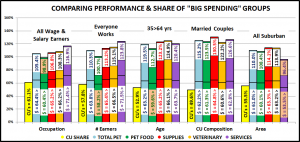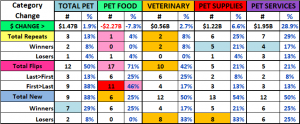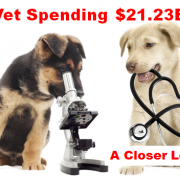Now we will turn our attention to the final Industry Segment – Veterinary Services. We’ll see some similarities to Services but some big differences from the Product Segments. For years, Veterinary Services prices have had high inflation. This has resulted in CU income becoming the most dominant factor in spending behavior and a reduction in visit frequency. Consumers paid more, just used Veterinary Services less often. The high inflation and prices also resulted in consumers trading Veterinary $ in reaction to big spending changes in other segments, primarily Pet Food.
Things changed in 2017 as Veterinary pricing had an all-time record low inflation rate. Consumers responded with a 7.2% increase in visit frequency and spent $2.5B more on Veterinary Services. In 2018 inflation began to return to more normal levels. Visit frequency fell slightly -0.2% and spending essentially plateaued. Consumers spent $0.56B more (+2.7%) but since inflation was 2.6%, virtually all of the lift was from increased prices. In this report we’ll look deeper.
We’ll start with the groups who were responsible for the bulk of Veterinary spending in 2018 and the $0.56B increase. The first chart details the biggest pet Veterinary spenders for each of 10 demographic categories. It shows their share of CU’s, share of Veterinary spending and their spending performance (Share of spending/share of CU’s). One difference from the product segments is immediately apparent. In order to better target the bulk of the spending we have altered the income group. Another difference is in performance – 6 of 10 groups perform above 120%. This is down from 7 in 2017 and now equal to Supplies. Services leads with 7 and Food trails with 4. This means that these big spenders are performing well but it also signals that there is a large disparity between the best and worst performing segments. Income is clearly the biggest factor in Veterinary Spending. The categories are presented in the order that reflects their share of Total Pet Spending which highlights the differences of the 9 matching categories.

- Race/Ethnic – White, not Hispanic (90.9%) up from (90.0%) This group accounts for the vast majority of spending in every segment., but a 91% share is extraordinary. The 131.7% performance rating ranks #3 in terms of importance in Veterinary Spending demographics and reflects the spending disparity. Hispanics, African Americans and Asians account for 31% of U.S. CU’s, but they only spend 9% of Vet $. Asians and African Americans have a significantly lower percentage of pet ownership and African Americans have the lowest average CU income.
- # in CU – 2+ people (81.6%) down from (84.1%) This group, which is over 70% of U.S. CUs, lost share and their performance fell from 118.0% to 115.7%. Even with a drop in performance, they still rank 7th in terms of importance in terms of Veterinary Spending. The loss in share and performance was driven by decreased spending by 2 and 3 person CUs in conjunction with a huge, $0.61B increase by singles.
- Housing – Homeowners (83.4%) up from (82.5%) Homeownership is a major factor in pet ownership and spending in all industry segments. In terms of importance to Veterinary spending, their 131.4% performance rating, up from 131.2%, keeps homeownership in 4th place. The slight increase in share and performance was driven by a $1.1B increase in spending by Homeowners w/Mtge. Everyone else spent less. We should note that Homeownership is not as important to Veterinary Spending as it once was. In 2015 their share was 88.4% with performance of 141.8%.
- Education – Associates Degree and Higher (76.3) up from (73.8%) Income generally increases with education. It is also important in understanding the need for regular Veterinary care. Market share was up as was performance, which went from 137.3% to 140.0%. Education became stronger as the 2nd most important factor in Vet spending. The lift came from BA/BS and Associates Degrees. All groups with a formal degree after HS performed at 119+%.
- Age – 35>64 (66.1%) up from (65.9%) This group switched back to 35>64 after a year as 45>74 because the 35>44 yr olds were up $0.8B while the 65>74 yr olds spent $0.2B less. Performance was also up, going from 123.4% to 124.9%. The gains would have been greater, but 55>64 spent $0.6B less. Age remained 5th in terms of importance.
- Occupation – All Wage & Salaried (66.5%) up from (65.8%) – All Wage and Salary Earners took over from “I’m the Boss”, which included Mgrs & Professionals, Self-employed and Retirees. Mgrs & Professionals and Self Employed drove the increase but they are not in the same group. This kept the the group’s share gain down and performance only increased from 107.5% to 108.3%. Occupation was #6 in importance. Now, it is the least important category.
- # Earners – “Everyone Works” (66.5%) up from (65.9%) In this group, all adults in the CU are employed. The share gain comes from a big year by working singles. Performance was basically steady, 115.1%, up from 115.0%. The gain from Singles was balanced by a spending drop by 2 earner CUs.
- Income – Over $70K (68.2%) up from (65.0%) We changed this group from over $50K because Veterinary Spending is so affected by CU income and the $70K level is where the behavior changes. Only the <$30K group spent less but the decrease was huge, -$0.8B. The performance of the $70K group stayed at 169.2%, clearly showing that higher income is THE most important factor in increased Vet spending.
- CU Composition – Married Couples (60.6%) down from (63.8%) Married couples have a big market share and 120+% performance in all segments. They loss share due to a big decrease from Couples only and an increase from singles and Unmarried, 2+ Adult CUs. Their performance also fell to 122.2% from 128.9%, but they moved up to 6th place in importance because the Occupation Category had an even worse year.
- Area – Suburban (63.2%) up from (62.9%) Suburban CU’s are the biggest spenders in every segment. They gained a little in share and in performance, which was 113.9%, up from 113.1%. They maintained the middle ground as Center City was up $0.79B while Rural america spent $0.64B less.
We changed 1 of the groups because Higher income is by far the biggest single factor in Veterinary spending. We see the impact of this in many groups as it often contributes to the big spending disparity between segments. The most notable changes were that occupation became less important, education moved up and spending skewed a little younger.
Now, we’ll look at 2018’s best and worst performing Veterinary spending segments in each category.

Almost all of the best and worst performers are those that we would expect. However, there are 6 that are different from 2017. This is much more than Supplies (3) but less than Services (8) and Food (7). This suggests some instability but unlike Food or Services, there is no big change in $, up or down. The changes from 2017 are “boxed”. We should note:
- Income – The 258.8% Performance by the $200K> group is down from last year’s 286.0% but is still very high.
- Generation – This is a Big Change. Boomers have “owned” this segment since….
- Occupation – Self -Employed took over from Mgrs & Professionals. They are the 2 highest income segments.
- Education – The BA/BS group took over from the usual winner, Adv. College Degree.
- Age – The 45>54-year olds, the group with the highest income, solidified their position at the top. By the way, only CUs in the 35>64 age range perform above 100%.
- CU Composition – It was a bad year for Married Couples Only and a good year for Singles, but both maintained their positions at the top and bottom of performance.
- # in CU – 2 people CUs, married or unmarried are the best performers. Single people perform better than only one other type of CU – the ones with 5 or more people.
- Region – Northeast won again – 4 straight years. The South is the only region performing below 100%.
It’s time to “Show you the money”. Here are segments with the biggest $ changes in Veterinary Spending.

Spending was up a modest 2.7% but there was turmoil, and this is where we see it. There were only 2 repeats and 10 segments flipped from 1st to last or vice versa. The only segment with more turmoil was Food. There were surprise winners – Gen X, 35>44, Center City, Singles and surprise losers – Boomers, Adv. Degrees, 55>64, Married Couple only. Last year there were 4 categories where all segments spent more . This year there were none. Here are the specifics:
- Housing – Homeowners w/o a Mtge flipped from 1st to last.
- Winner – Homeowner w/Mtge – Veterinary: $11.90B; Up $1.13B (+10.5%)
- Loser – Homeowner w/o Mtge – Veterinary: $5.80B; Down $0.49B (-7.7%)
- Comment – Last year all groups spent more. This year it was only Homeowners w/Mtge. The Homeowners w/o mtge numbers were driven down by a big spending decrease by Retirees.
- Generation – Gen X just edged out Millennials for the win.
- Winner – Gen X – Veterinary: $6.67B; Up $0.91B (+15.9%)
- Loser – Baby Boomers – Veterinary: $8.21B; Down $1.76B (-17.7%)
- Comments – The Boomers were the only generation to spend less on Veterinary Services. One factor was their adult children moving out to their own homes. The other Generations spent more producing a positive result.
- Education – Those with a BA/BS Degree are repeat winners and are up $2.48B (+44%) since 2015.
- Winner – BA/BS Degree – Veterinary Spending: $8.06B; Up $0.90B (+12.6%)
- Loser – Adv. College Degree – Veterinary Spending: $5.39B; Down $0.50B (-8.5%)
- Comment – Associates Degree had a big turnaround and got out of the cellar with the biggest increase of any segment, +24.9%. They were replaced at the bottom by Adv. Degrees, an unusual spot for this group.
- Age – Last year the winner was the older Gen Xers – 45>54. This year it is their younger siblings – 35>44.
- Winner – 35>44 yrs – Veterinary Spending: $3.83B; Up $0.84B (+28.3%)
- Loser – 55>64 yrs – Veterinary Spending: $4.78B; Down $0.64B (-11.9%)
- Comment: Veterinary spending by age group was a mixed bag. <25: +$0.14B; 25>34: -$0.02B; 35>54: +$1.03B; 55>74: -$0.88B; 75+: +$0.31B. As you look at the ups and downs, a spending rollercoaster ride “ for the ages” might be a more apt description of the pattern in this category. By the way, the 75+group was up 39%.
- Region – A dual flip in this category.
- Winner – Midwest – Veterinary Spending: $5.00B; Up $0.80B (+19.0%)
- Loser – Northeast – Veterinary Spending: $4.33B; Down $0.33B (-7.2%)
- Comment – The South finished second again. The Northeast lost but are still the best performing segment.
- Area Type – Central City flipped from last to first.
- Winner – Central City – Veterinary Spending: $6.47B; Up $0.79B (+13.8%)
- Loser – Rural – Veterinary Spending: $1.34B; Down $0.64B (-32.2%)
- Comment – Central City led the way, but all areas except Rural spent more.
- Race/Ethnic – With a 91% share of Veterinary $, White, non-Hispanics increased their dominance in this segment.
- Winner – White, Not Hispanic – Veterinary: $19.31B; Up $0.71B (+3.8%)
- 2017: White, Not Hispanic
- Loser – Asian American – Veterinary: $0.17B; Down $0.24B (-58.9%)
- Comment – Asian Americans have low pet ownership but the highest income. They spent 59% less. African Americans have low pet ownership and the lowest income. They spent 60% more. Hispanics are 2nd in pet ownership and 3rd in income. They spent 20% less. There is no clear pattern for minority spending.
- Occupation – Self-Employed flipped from last to first.
- Winner – Self-Employed– Veterinary Spending: $2.11B; Up $0.64B (+43.5%)
- 2017: Mgrs & Professionals
- Loser – Retired – Veterinary Spending: $3.54B; Down $0.62B (-15.0%)
- Comment – Self-Employed and Mgrs & Professionals spent $1.02B more. This overcame the $0.62B decrease by Retirees. Blue Collar workers also posted a $0.12B increase, but the Tech/Sls/Clerical group spent $0.04B less.
- CU Composition – A final double flip.
- Winner – Single – Veterinary: $3.90B; Up $0.61B (+18.6%)
- 2017: Married, Couple Only
- Loser – Married, Couple Only – Veterinary: $6.77B; Down $0.57B (-7.8%)
- Comment – Singles had a strong year in every category. In Veterinary spending Unmarried 2+ Adult CUs and Single Parents also spent more. For all Married CU’s, only those with an oldest child over 6 had an increase.
- # in CU – Singles flipped from last to first.
- Winner – Single – Veterinary Spending: $3.90B; Up $0.61B (+18.6%)
- Loser – 3 People – Veterinary Spending: $3.60B; Down $0.32B (-8.3%)
- Comment: The winning numbers were 3 and 1. CUs of all other sizes spent less.
- # Earners – The winner flipped from last to first and would be a big surprise in most years.
- Winner – 1 Earner, Single – Veterinary Spending: $2.57B; Up $0.55B (+27.5%)
- Loser – No Earner, 2+ CU – Veterinary Spending: $1.61B; Down $0.39B (-19.4%)
- Comment – While Income is of primary importance to increased Veterinary Spending, the number of earners remains on the lower tier of spending drivers. The 2018 Veterinary spending data reinforces this. 1 Person CUs, with 1 or no earner spent more. In 2+ person CUs, No Earners and 2 Earners spent less while 1 and 3+ Earners spent more. 2 and 3+ Earner CUs have the highest incomes but are in opposite “camps”. There is no clear spending pattern in the # of Earners category.
- Income – In 2018, $150 to $199K was the winner. The winner is inevitably an over $100K group in this segment.
- Winner – $150 to $199K – Veterinary Spending: $2.74B; Up $0.33B (+13.7%)
- Loser – <$30K – Veterinary Spending: $1.79B; Down $0.77B (-29.9%)
- Comment – The only group to spend less was <$30K but the lift was driven by $70K>, +$1.05B.
We’ve now seen the winners and losers in terms of increase/decrease in Veterinary Spending $ for 12 Demographic Categories. 2018 saw slow growth in Veterinary spending, mostly in the second half. There was a surprising amount of turmoil with 22 of 24 winners/losers being new or flipping positions. Most of the winners were not unexpected but there were some surprises like Gen X, 35>44 and Singles. This reinforces the “youth movement” in Veterinary Spending. However, there were also “hidden” segments that didn’t win but made a significant contribution to the 2018 spending increase. These groups don’t win an award, but they certainly deserve….
HONORABLE MENTION

First let’s call out a Blue Collar subsegment. Construction/Mechanics, +98.5%. African Americans also earned their spot, +60.3%. It wasn’t all about youth as the oldest Americans spent 38.9% more. Formal Education is also important but not just College Grads. Assoc. Degree spent $0.55B more. 4 People CUs and Millennials also had big increases reinforcing the youth movement. While the lift wasn’t as big as last year, it was still widespread as 58 of 92 demographic segments (63%) spent more on Veterinary Services in 2018.
Summary
2016 and 2017 produced a combined increase of $3.6B in Veterinary Spending as inflation moved to record low levels. In 2018 we had the Baby Boomer Spending “Bust” which especially impacted Food and Veterinary. They dialed back their Food upgrade and cut back on Veterinary. Another significant factor was that many adult children moved out of their parents’ homes to become financially independent. This group, plus the Gen Xers stepped up to overcome the decrease from the Boomers. Veterinary Spending became a little more balanced in terms of age and also occupation in 2018.
Veterinary services and spending should be a definite need, like Food, but there are many indications that it is becoming more discretionary and determined by income. It is very obvious when we look at performance. (Share Vet $/Share CUs)
- <$30K – 29.4%
- $30>50K – 71.7%
- $50>70K – 80.3%
- $70>99K – 119.1%
- $100>149K – 161.5%
- $150>199K – 209.1%
- $200K> – 258.8%
The “break even” point (100%) occurs at $70K+. CU’s over $70K (40.3%) account for 68% of Veterinary $. In 2018 this group continued to grow in numbers and gained share. Performance remained steady at 169%. One lower income group, $40>49K had a strong year, +28%. However, the <$30K group has almost become a non-participant in Veterinary.
The performance of other big spending groups is also very important in the Veterinary segment. We identified six demographic categories with high performing large groups. (There were 7 for Services, 6 for Supplies and 4 for Food) . Consumers have no control over Race/Ethnicity or Age but in addition to Income – Education, Homeownership, and Marriage are important factors in Veterinary spending. The high performance in these groups also demonstrates the big spending disparities among segments within these categories.
There were some changes of note. Occupation ceased to be a major factor in spending, but formal Education after HS became even more important. Marriage lost ground as Singles stepped up their spending. Veterinary spending also skewed younger in 2018 so the big age group changed back to 35>64 from 45>74.
2018 saw a small spending increase (+2.7%) for Veterinary Services. 63% of all segments increased spending but with a 2.6% inflation rate, almost all of the lift came from prices. The lift was driven by Gen Xers and Millennials which was reflected in the strong performance of numerous segments like Singles, Married with oldest Child over 6, Center City and 35>44 yr olds. The importance of income to spending in this segment was reinforced and a definite concern came to the forefront. CUs with income <$30K (29%) spend 15% of Food $ but only 8% of Veterinary $. Is inflation putting necessary Vet Care out of reach for this group? In 2019 Veterinary Inflation jumped to 4.14%. We’ll see what happens.
Finally – The “Ultimate” Veterinary Services Spending Consumer Unit consists of 2 people – a married couple only. They are in the 45 to 54 age range. They are White, but not of Hispanic origin. At least one of them has a BA/BS Degree. They both work in their own business and their total income exceeds $200K. They live in a small suburb, adjacent to a big city in the Northeastern U.S. and are still paying off the mortgage on their home.

